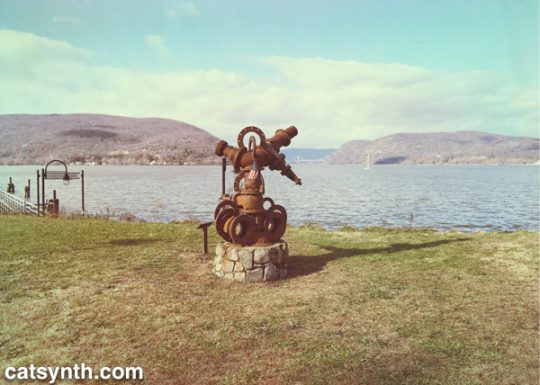
Sculpture at Fleishmann Pier in Peekskill, NY. We see the Hudson River and the Bear Mountain Bridge in the distance.
Last week’s Wordless Wednesday was also taken in Westchester County along the Hudson River.


Sculpture at Fleishmann Pier in Peekskill, NY. We see the Hudson River and the Bear Mountain Bridge in the distance.
Last week’s Wordless Wednesday was also taken in Westchester County along the Hudson River.
After seeing Kwang Young Chun’s Aggregations at Sundaram Tagore Gallery (read our review of that show), I knew I needed to check out his solo exhibition at the Brooklyn Museum. I expected more of the same style of abstract triangulated paper constructions, but on a larger scale. And I was not disappointed.
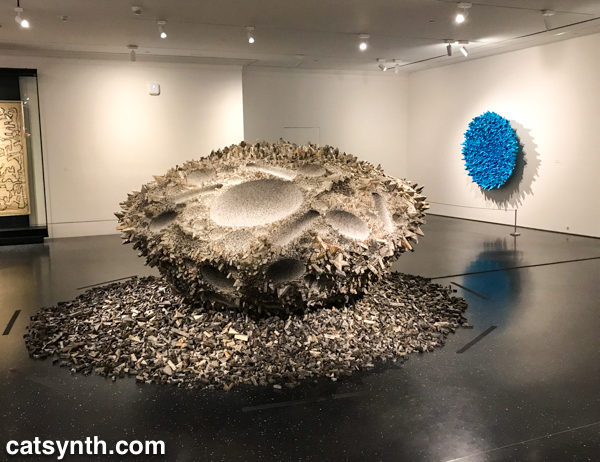
These large other-worldly constructions are formed from small tightly folded prisms of mulberry paper. This thin and delicate paper is prized as an artistic material but also has mundane uses as wrappers. Chun primarily sources his paper from old books.
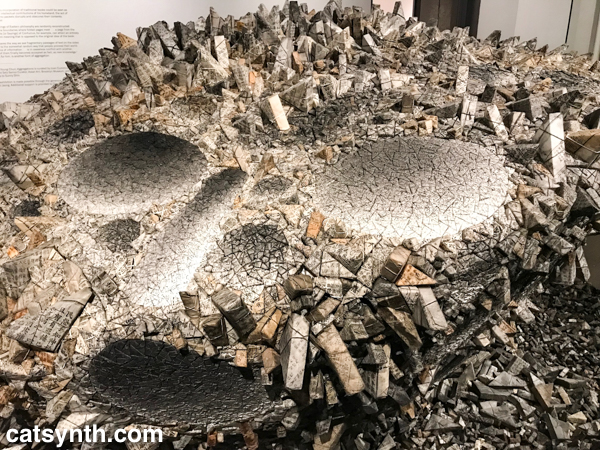
The freestanding central piece, which I believe was Aggregation 15-JL038 (his titles all rather cryptic alphanumeric combinations), was particularly intense and seemed like a cratered surface of a large asteroid. The remaining pieces were wall-mounted, but still combined light and shadow, roughness and smoothness, in a similar way.
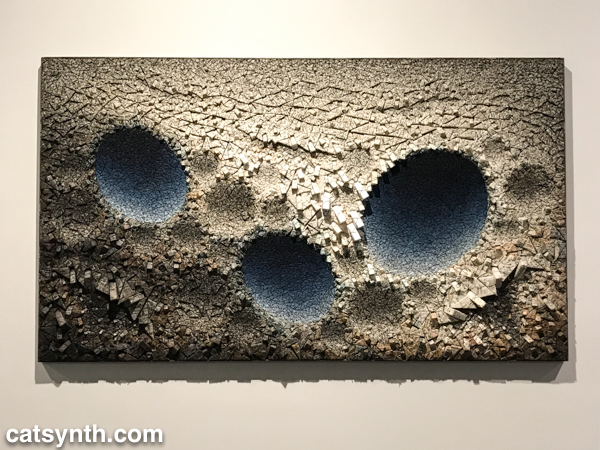
There is something I find deeply captivating about Chun’s sculptures. They seem like something I might have generated on the computer, but they are made of paper. They seem solid and heavy, but fragile at the same time. I also liked the juxtaposition of blue with the otherwise grayscale elements. I found myself sitting in the middle of the gallery and contemplating each of them for a long time, longer than I usually sit with individual pieces on a whirlwind trip through a museum.
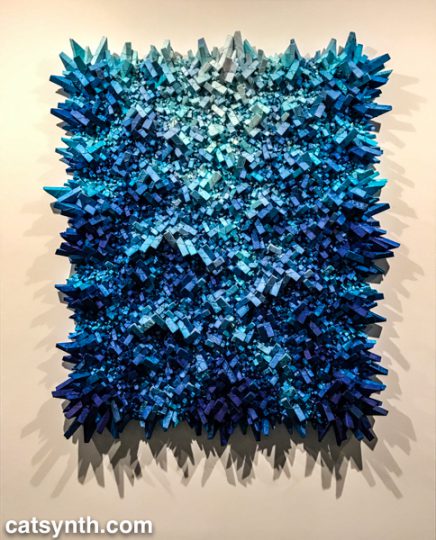
Blue seemed to be the color of the day. Even before reaching Kwang Young Chun’s exhibition, I was greeted by Infinite Blue, a survey of art and design objects from the museum’s collection.
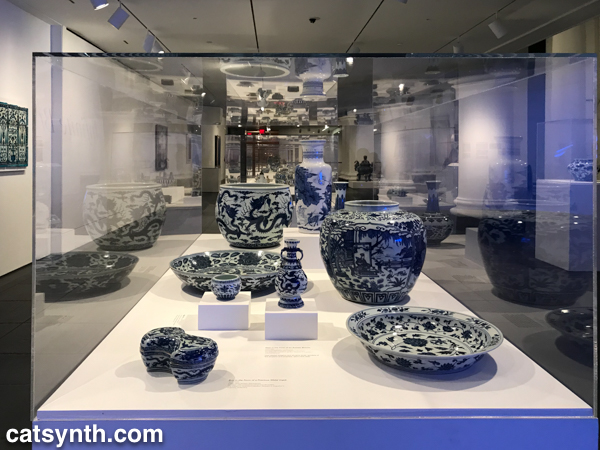
I have long been drawn to blue – along with purple, it is a color I welcome into my own art and design, and one of the few colors that I wear. It’s also historically a rarer color and one that is not often found in nature (other than the blue tint of the sky and water). The exhibition goes through different places and periods of art and craft incorporating blue, often juxtaposing traditional objects with contemporary art. For example, the Chinese porcelain in the image above was paired with contemporary paintings by Chinese artist Su Xiaobai.
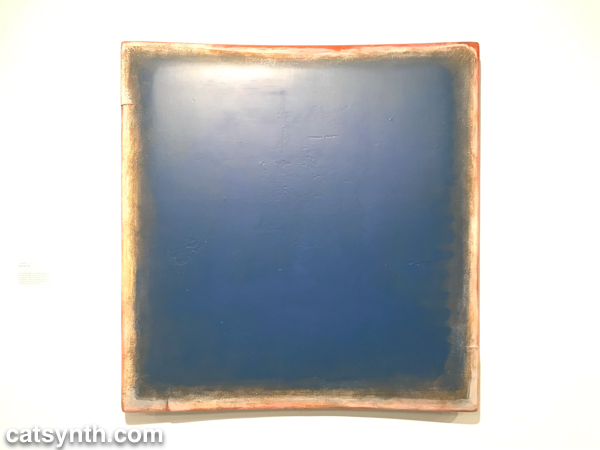
I tend to be most drawn to objects that are more abstract and geometric. As such, the section featuring 19th-century American decorative arts did nothing for me. By contrast, I enjoyed seeing a Korean 19th-century porcelain bottle with 20th-century American designs in blue glass.
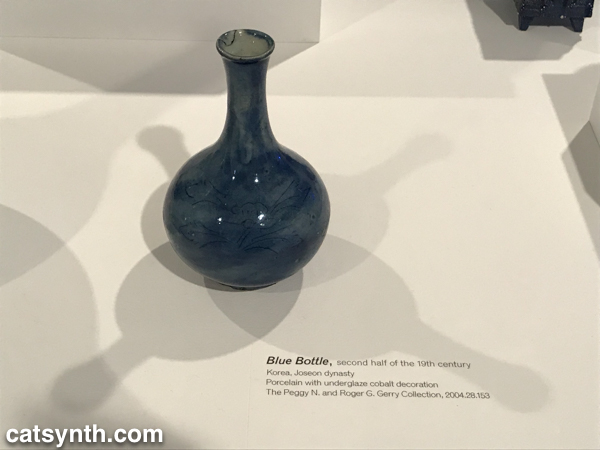
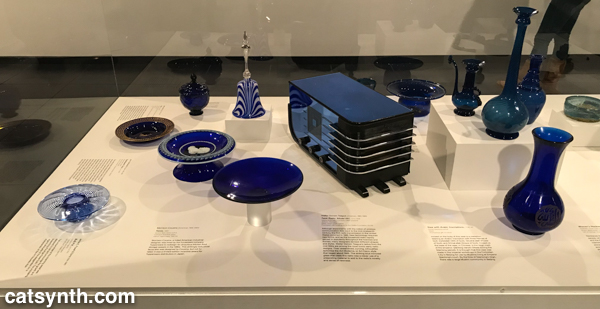
I do, however, have a soft spot for fish.
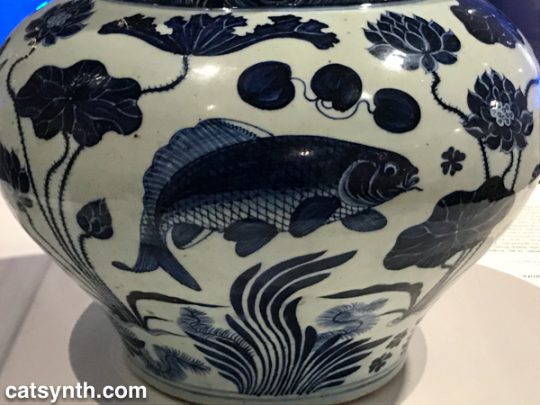
The most powerful element tying the entire exhibition together was the opening piece, one of Joseph Kosuth’s neon text works 276 (On Color Blue).
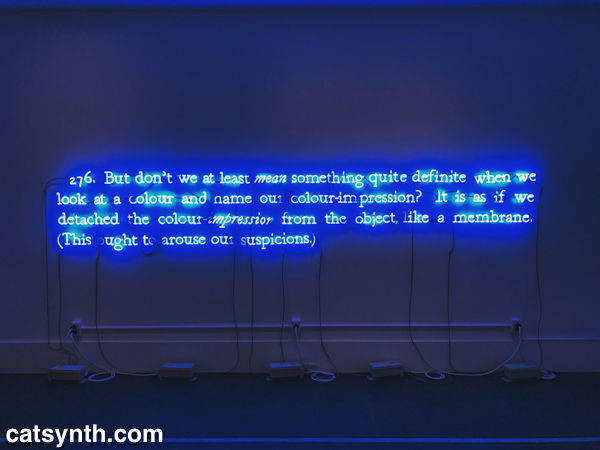
And this is perhaps a fitting way to close this article. There was more to see and share from this visit to the Brooklyn Museum, but we shall save that for a subsequent article.
We at CatSynth have long been interested in the intersection of art, technology and conceptual process. Programmed: Rules, Codes, and Choreographies in Art, 1965–2018 surveys over 50 years of video, computational and conceptual art, cleverly weaving them together into a single narrative whole. The three disciplines are united by the concept of a “program” or set of instructions through which the work of art unfolds, whether a computer program, instructions for a performance, or strict concept on a visual object. Video and lights abound, but there is also painting, dance, and more.
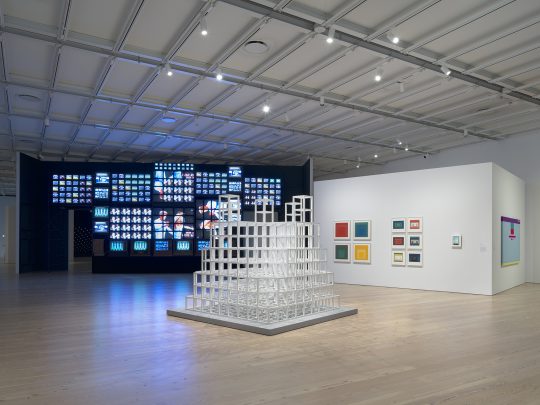
One of the artists who
At the opposite end of the video spectrum is his 1965 piece Magnet TV. A black-and-white CRT television set is disrupted by a large magnet, creating a unique but sometimes unpredictable pattern that is in its way rather spare and graceful.
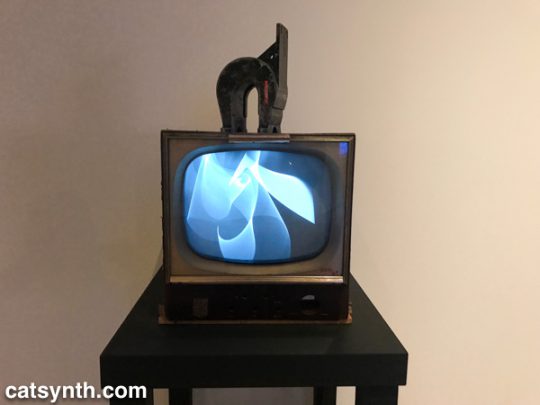
In the first piece, the process is in the composition, arrangement, and looping of the various video clips. In the latter, it is the physics of the magnet and the CRT.
Motion and experiments with electronics are also at the heart of James L. Seawright’s contemporaneous piece, Searcher, which features gradual motion and changes in light. The shadows it casts are also part of the experience of the piece.
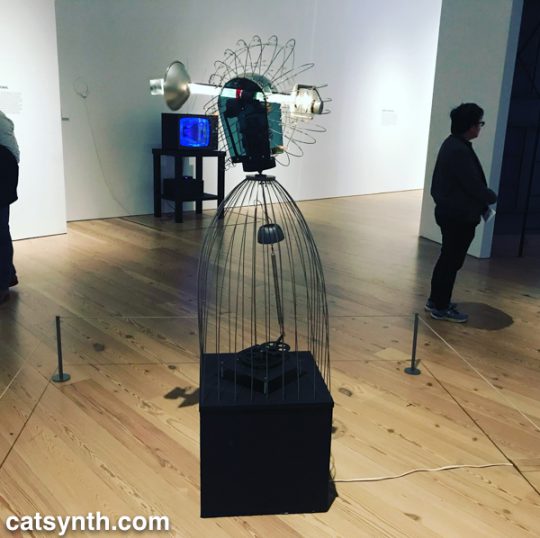
There is an interesting juxtaposition of one Joseph Kosuth’s classic neon text pieces, Five Words in Green Neon, and W. Bradford Paley’s Code Profiles, a Java program that generates images. They bring together the concepts of “text as art” and “code as art” – the message is the medium.
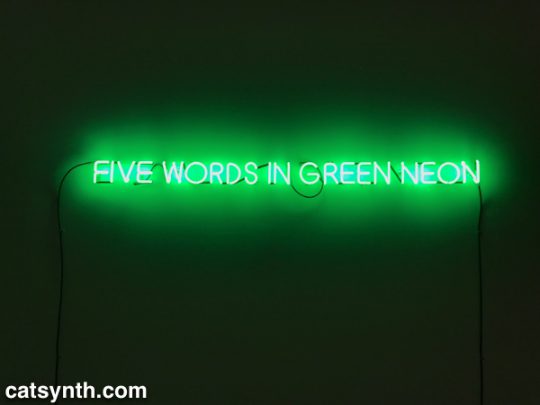
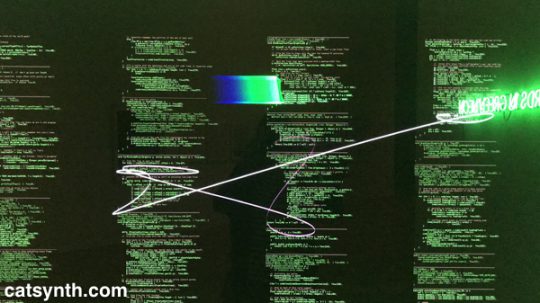
Paley’s code may be one of the most literal examples of the exhibition’s theme, but code need not be computer code as we think of it today. Many works from earlier periods were based on a series of instructions, where the instructions are the work and the performance or visual object are the expressions of said work. One such example is Sol Le Witt’s sculpture Five Towers. The three-dimension grids are assembled by a program with various combinations into a simple but beautiful result. I particularly enjoyed looking through it.
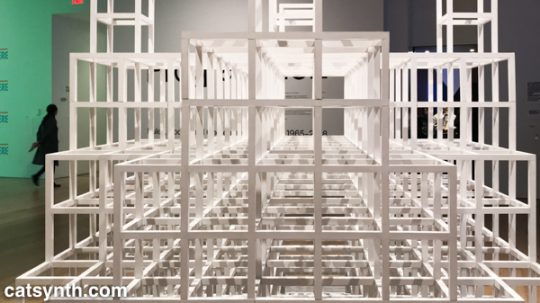
Josef Albers’ color-field rectangles can similarly be generated from a “program”. Like Le Witt’s piece, one could conceive of doing something like this with a computer, but neither artist chose to do so, instead being themselves the interpreters for the code.
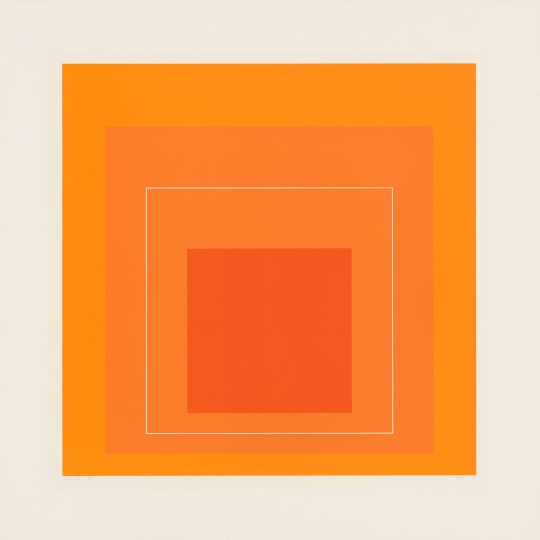
The performing arts have long been linked to programs, whether the traditional score or choreography, or more modern uses of algorithms or conceptual instructions.
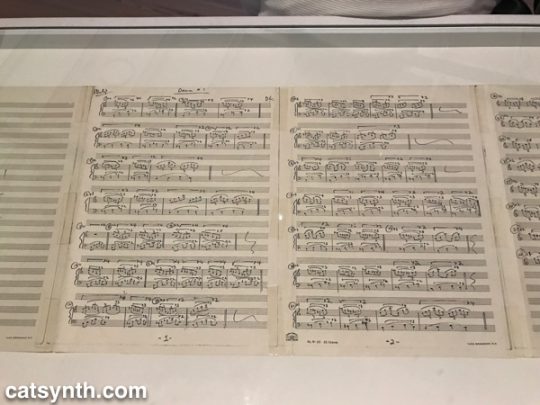
Program, object, video and performance also come together Lynn Hershman Leeson’s Lorna. Lorna is an interactive video story on a laser disc (anyone else remember laser discs?). Users can determine how the story unfolds through one of three endings via a remote control. The screen and control are placed within a simulated apartment decked out entirely in leopard print, and the viewer is invited to sit in a comfy chair while the controlling the story. This self-guided performance is at once programmed, but also immersive in that the viewer becomes part of the piece, both in space and in terms of control.
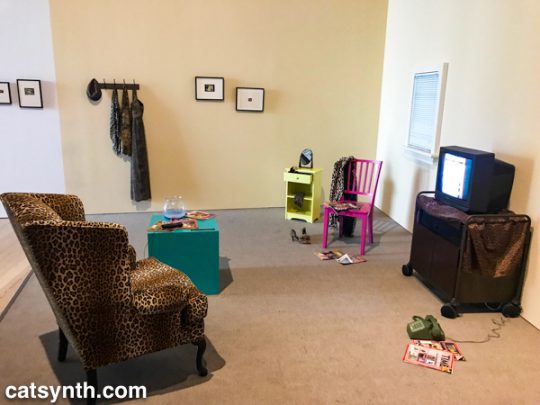
Video permeates the entire exhibition, popping up directly and indirectly in at least half of the pieces, or not more. But
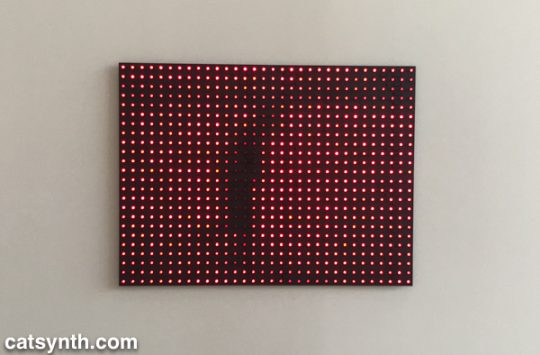
We conclude this survey with a new site-specific commission by Tamiko Thiel. She created an augmented-reality mobile app (in collaboration with developer /p) that overlays organic forms on the angular, geometric space of the museum’s outdoor terrace.
Thiel’s organic growths are beautiful and playful, but also have a darker aspect. Some resemble plastic refuse, and others coral formations. Both are emblematic of the crises facing our seas due to pollution and climate change. At the same time, the algorithmic process she uses, a formal grammar developed in 1968 by the Hungarian biologist and botanist Aristid Lindenmayer, is fascinating.
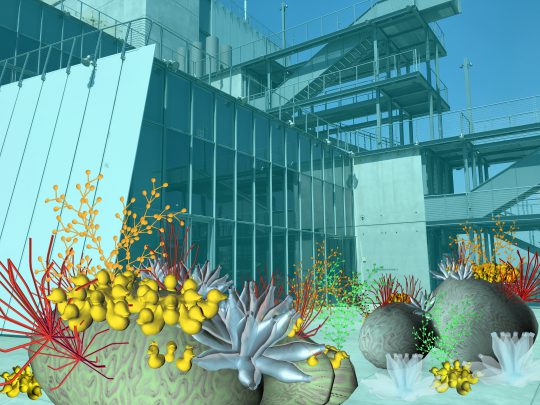
There were many more works in this exhibition that we can discuss in a single article. Each one had something compelling and different about it. For anyone interested in or curious about these forms of art, I highly recommend checking out this exhibit!
Programmed: Rules, Codes, and Choreographies in Art, 1965–2018 will be on display at the Whitney Museum of American Art through April 14, 2019.
The Art of Paper is a multi-artist exhibition currently on display Sundaram Tagore Gallery at their Chelsea location. The term “works on paper” often refers to drawing and print, but the medium and can be used in so many more ways. Each of the artists in the show uses paper in a very different way, showcasing its breadth and versatility as a raw material for art.
Korean artist Chun Kwang Young creates fantastic three-dimensional sculptures from mulberry paper. This thin and delicate paper is prized as an artistic
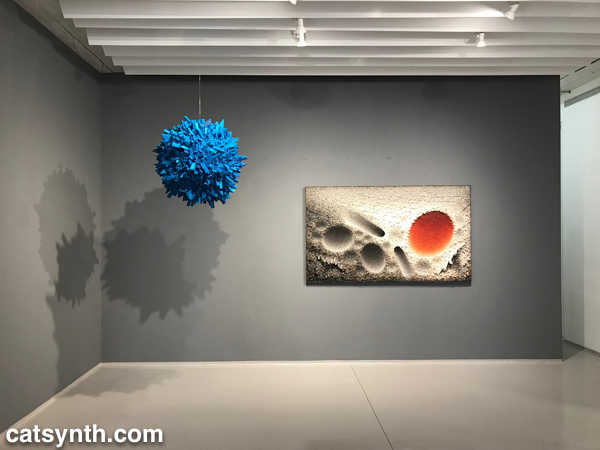
Some are flat and wall-mounted while others are freestanding. But in all cases, they are three-dimensional full of complex depth and texture.
The jagged triangular elements seem sharp, even a bit dangerous up close. But at the same time, they seem fragile, like delicate crystals that could fall apart among touch. When viewing closer, they seem soft, especially as the details of the paper come into view, including the original printed text from the source material. There is something almost science-fiction-y and other-worldly about the result that I find captivating.
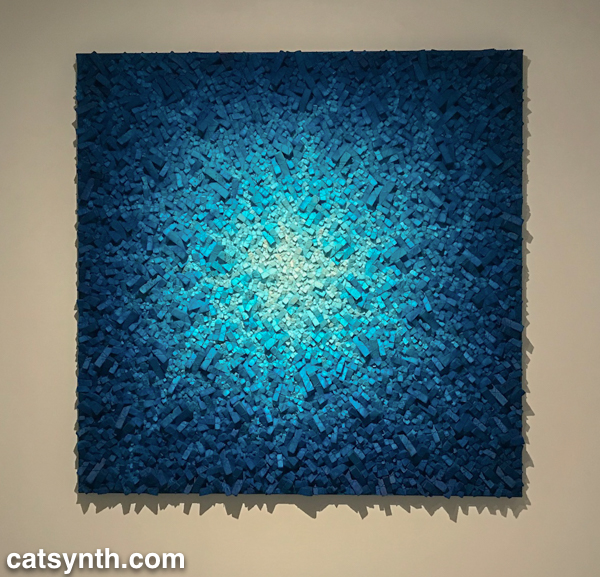
Chun has a simultaneous solo exhibition from his Aggregations at the Brooklyn Museum, which we will be reviewing in a separate article.
The work of Anila Quayyum Agha also uses paper as a basis for sculpture with a very different set of styles, techniques, and sensibilities. She is best known for her works featuring paper laser-cut into large intricate forms. Many of the paper cuts are assembled into cubes placed in immersive spaces with light.
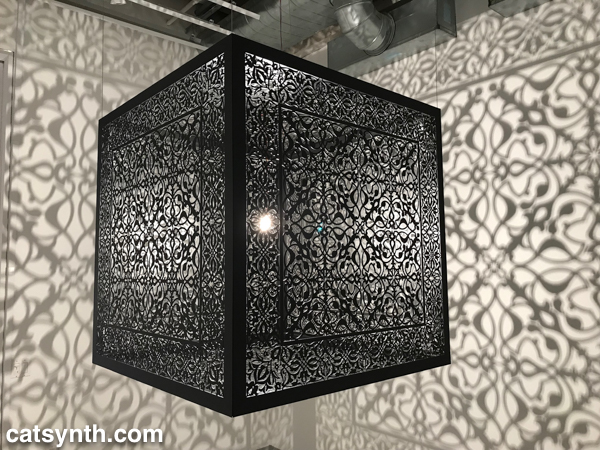
Being in the space of this piece and viewing it from all angles was a captivating experience. It doesn’t seem like paper, but rather intricately carved stone or metal. S
In contrast to Agha’s highly intricate designs, Miya Ando’s work is more subtle and spare. She is known for more abstract work in metal, but she brings that work to paper in her “moonlight” pieces for this show.
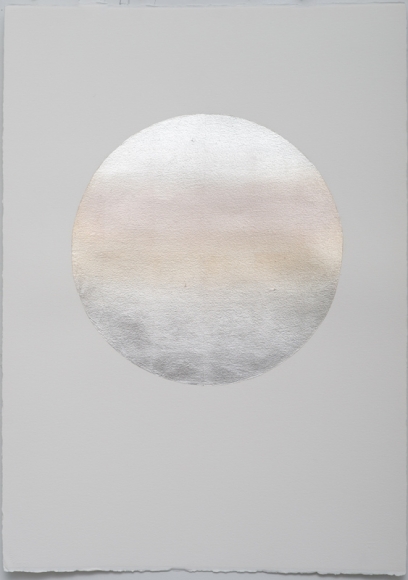
Paper is often white, but it can be many different whites and shades in between those gradations. The subtle changes give the round form a very natural feel in contrast to the stark white background.
There are several more artists in this show, more than we at CatSynth are able to cover in this article. For more information, please visit the gallery’s website. They are located at 547 West 27th Street, and the exhibition will be on display through December 15, 2018.
Greetings, and happy third night of Hannukah! Today we look at the Soundtracks exhibition currently on display at the San Francisco Museum of Modern Art (SFMOMA) through the end of the year. It is also the subject of our most recent CatSynth TV episode.
The exhibition explores the intersection of sound, visualization, and space, and features over 20 artists. There are a variety of interpretations and methods of making sound, from acoustic to mechanical to electronic. None of the sound installations are overpowering, but many do arrest ones attention. Upon arriving at the 7th floor for the exhibition, one is created by Anri Sala’s Moth in B-Flat, which features a mechanically triggered snare drum hanging inverted from the ceiling.

[Anri Sala. Moth in B-Flat (2015_]
The electro-mechanical theme continues with O Grivo’s Cantilena, which includes several motorized sound-making sculptures primary made of wood.

[O Grivo. Cantilena (2017)]
These were fun to watch, and I found myself wanting to make one myself (we shall see if that actually occurs).
Simplicity reigned in Céleste Boursier-Mougenot’s clinamen v.3. A large shallow pool of water contained floating ceramic bowls. The frequent collisions of the bowls created a music that was very captivating.

[Céleste Boursier-Mougenot. clinamen v.3 (2012–ongoing)]
This piece was deeply calming, and I found myself zeroing in on groups of bowls as they collided and separated to form rhythms and harmonies.
Ambient soundscapes were also the heart of an installation by Brian Eno, New Urban Spaces Series #4: “Compact Forest Proposal,”, with a darker tone and more complex technology.

[Brian Eno.New Urban Spaces Series #4: “Compact Forest Proposal” (2001)]
One is free to wander the darkened space amidst the moving columns of LED lights. Every once in a while, the light increases and one gets glimpses of shadowy figures on the wall. The sounds ranged from small percussive synth hits to trumpets to electronic noise.
Electronic noise was also at the heart of Christina Kubisch’s installation Cloud. Kubish’s work explores sonification of data and electricity. The mass of red electrical wires emits electromagnetic radiation, which was interpreted as sound using customized headphone devices.

[Christina Kubisch. Cloud (2011/2017)]
Of all the installations, this was the among the most challenging to take in sensually or to document. I love the concept, and I think it really needs an extended period of time alone to experience fully.
From the large to the small. We had fun with Sphere Packing by Rafael Lozano-Hemmer, which featured several spherical speaker arrays made from those ubiquitous white Apple earbuds.

[Rafael Lozano-Hemmer. Sphere Packing (2013 and 2014)]
Each was playing a different selection of classical music from the 18th, 19th and 20th centuries, rearranged and diffused asynchronously through the speakers. Lozano-Hemmer also had an installation Last Breath that included a recording of breathing by the late Pauline Oliveros.
We conclude with another project visualized as a sphere. Lyota Yagi’s Sound sphere featured a sphere wrapped in cassette tape that freely rotated and revolved. Customized pickups rendered the sound from the tape, which is chopped, looped and distorted based on the chaotic motion of the sphere.

[Lyota Yagi. Sound Sphere (2011)]
All of these pieces were inspiring for my own work, as I want to do more sound installation in the coming year. There were more in the main the exhibit and spread around the museum, but beyond what I can cover in this article. We do encourage you to check out our video to hear how some of these pieces sound. And if you are in the Bay Area, we strongly recommend checking the exhibition out before it closes on January 1, 2018.
Our initial report from MoMA focused on the current exhibition of print and 2D works by Louise Bourgeois. But in November, the entire museum was a trove of intriguing exhibitions – even with the current construction – and today we look at four more of them.
We begin with Max Ernst: Beyond Painting, a survey exhibition built around the celebrated Dada and Surrealist artist’s frequent description of his own practice as “beyond painting.” It does actually include paintings, but also is many early drawings and works on paper as well as his sculptures and early conceptual work.
Ernst first came to prominence as the founder of the Cologne branch of Dada after World War I (in which he served in the German army). Like other in the Dada movement, much of his work was deliberately provocative and low-fi and went outside of traditional artistic practice. One of the seminal works from this early period was the portfolio Let There Be Fashion, Down with Art, which mixes technological drawings, equations and other elements in absurd and non-sensical ways. Despite the tone and organizing concept, some of the individual illustrations are quite beautiful.

In the above page, we see a feminine figure juxtaposed with geometric and architectural elements. It could have easily been one of Louise Bourgeois’ drawings from three decades later! It also reminded me of the composition in some of my photography.
“Beyond Painting” did include paintings, particularly from Ernst’s surrealist period after relocating from Cologne to Paris.

[Max Ernst. The Nymph Echo (La Nymph Écho). 1936. Oil on canvas.]
The hard-edged lines have given way to the dreamy organic shapes frequently employed in surrealism. But Ernst’s renderings have more of a biological feel – there is abundant vegetation, and some elements appear as microscopic life forms but on a human scale.
Despite his reputation as a provocateur within the often dark worlds of Dada and surrealism, Ernst’s work often has a very playful quality, even endearing at times. That comes out most in his sculptures, some of which can even be described as “adorable”

[Max Ernst. An Anxious Friend (Un ami empressé). 1944 (cast 1973)]
This one, in particular, is worth walking around, as there is another figure on the back side.
The exhibition culminates with 65 Maximiliana, an illustrated book co-created with book-designer Iliazd.
[Max Ernst. Folio 10 from 65 Maximiliana or the Illegal Exercise of Astronomy (65 Maximiliana ou l’exercice illégal de l’astronomie). 1964. Illustrated book with twenty‑eight etchings (nine with aquatint) and six aquatints by Ernst and letterpress typographic designs by Ilia Zdanevich (Iliazd). Page: 16 1/16 × 12 1/16″ (40.8 × 30.7 cm). Publisher: Le Degré 41 (Iliazd), Paris. Printer: Georges Visat. Edition: 65. The Museum of Modern Art, New York. Gift of David S. Orentreich, MD, 2015. Photo: Peter Butler. © 2017 Artists Rights Society (ARS), New York / ADAGP, Paris.]
In addition to Ernst’s aquatint illustrations and Iliazd’s fanciful typography, the book also features a completely invented hieroglyphic script by Ernst. It brings his career full circle to those early Dada books from Cologne.
As described above, beauty and artistic interest often originate outside traditional artistic practices. The exhibition Thinking Machines explores the artistic ideas that emerged alongside early computer technologies as well as the beauty of the devices themselves.
It is easy in the age of ubiquitous, distributed, and often invisible computing that the most powerful computers were singular and central elements of many workplaces and institutions. The Thinking Machines CM-2, made in 1987, both fits in the emerging dystopian future imaged in the era but also collapses complexity to beautiful patterns in the red LEDs against the black cubic casing. Apple has always been known for their design, and some of their early offerings were featured, including the Macintosh XL (successor to the infamous Lisa).

While the machines themselves were works of art, artists immediately saw their potential for exploring new ways of creating – we can only imagine what Max Ernst might have done with these technologies! But we don’t have to imagine with others, such as John Cage. Here we see both the score and record for HPSCHD, his collaboration with Lejaren Hiller that featured computed chance elements and computer-generated sounds on tape alongside live harpsichords.

The intersection of music and technology is at the core of what we do at CatSynth, but we have also long been interested in technology in other arts. The exhibition included samples of sonakinatography, a system of notation for motion and sound developed by Channa Horwitz.

The notation system uses numbers and colors arranged in eight-by-eight squares and can be used to represent music, dance, lighting, or other interpretations of motion over time. The notation and a proposed work were submitted by Horwitz for 1971 Art and Technology exhibit at LACMA – although the proposal for the piece with eight beams of light was included in the catalog, it was never fabricated. Horwitz work was buried beneath the work of male artists and she was not invited to speak or meet with industry representatives collaborating on the exhibition. This led to an outcry about the exhibition’s lack of women, a problem that echoes to this day in the world of art and technology. Fortunately, women were recognized in this MoMA exhibition of early technology in art. In addition to Horwitz, we saw work by Vera Molnár, a pioneer of computer art. In the print below, she digitally riffs on a drawing by Paul Klee.

Surprisingly, MoMA has rarely delved deeply into fashion in its exhibitions. For a long time, the biggest major exhibition the museum held for this medium was Bernard Rudofsky’s 1944 exhibition Are Clothes Modern?. But the museum is revisiting the topic in a major way with the current Items: Is Fashion Modern? a deliberate play on Rudofsky’s original title. The exhibition includes 111 garments and accessories and places them in both conceptual and chronological organizations. There are of course mainstays of fashion such as the “little black dress.”

It is hard to look at a fashion exhibition without thinking “Would I or would I not wear this?” In the above example, the dress on the left is something I would wear, while the one on the right is something I would not (except perhaps as a costume for a film, etc.). But side by side they show a range of tastes and styles and how they shape and reflect our images of our own bodies. The most intriguing design in the “I would wear this” category was this dress from Pierre Cardin’s “Cosmos Collection”. Even if this was intended to represent “the future”, I could see it easily working in the present, whether the present is 1967 or 2017.

[Cardin. COSMOS]
The exhibition did also touch on new technologies and innovations, such as with this dress that uses 3D printing technology.

[Jessica Rosenkrantz and Jesse Louise-Rosenberg. Kinematics Dress. 2013. Laser-sintered nylon.]
Of course, not all fashion is “high fashion”, and the exhibit deliberately covered both. There were the ionic baseball caps of the New York Yankees and their evolution over the years (someone had to design each one of them). And even a display of Jewish kippas, ranging from the simple to the whimsical.

I was particularly amused to see the Yankees-themed kippa. It was two “religions” colliding.
Our final exhibition is the MoMA’s large and comprehensive retrospective of works by photographer Stephen Shore. I have to admit, I was not particularly acquainted with Shore’s work, and after touring the exhibition I realize I should have been. In many ways, Shore’s work is photography writ small, often employing simple camera technologies, including a novelty Disney toy camera from the 1970s and Instagram on an iPhone in his current work. And his subjects range from the foment of 1960s New York and Andy Warhol’s Factory to stark rural landscapes.

[Stephen Shore. New York, New York. 1964. Gelatin silver print, 9 1/8 × 13 1/2″ (23.2 × 34.3 cm). © 2017 Stephen Shore, courtesy 303 Gallery]

[Stephen Shore. U.S. 93, Wikieup, Arizona, December 14, 1976. 1976. Chromogenic color print, printed 2013, 17 × 21 3/4″ (43.2 × 55.2 cm). The Museum of Modern Art, New York. Acquired through the generosity of Thomas and Susan Dunn. © 2017 Stephen Shore]
I particularly like the “ordinary” nature of some of the settings, main streets, highways, abandoned booths. The juxtaposition of New York against the small town and rural landscapes feels quintessentially American. Shore was also known for working in color, especially after leaving New York – this was something that wasn’t done so much in the world of art photography at the time. He also deliberately subverted the idea of art photography at times, including in his 1971 exhibition All the Meat You Can Eat, which was composed mostly of found imagery (commercials, postcards, snapshots) in dissonant arrangements that were more theatrical than anthropological.
Shore also did commission work. A few of these took him abroad, including to Israel, where he combined his interests in photography and archaeology. His most recent work fully embraces the modern technology of Instagram sharing – you can follow Shore’s Instagram account – and on-demand printing. The subject matter is varied, often focusing on small-scale or interesting framing of everyday items, but there are also occasional snaps that wouldn’t appear out of place on a tasteful personal account.
It’s not uncommon for me to be inspired to pursue my own work after an exhibition. This was certainly an example, as Shore’s photography mirrors many of own work in the medium, particularly focusing on place and texture, as well as traveling the country to pursue one’s art. Indeed, the inspiration was a bit more poignant because wondering the images I felt that this was exactly what I should be doing. It perhaps that realization that led me to tear up a bit as I left.
This fall and winter in New York featured an ambitious citywide art project by Ai Weiwei called Good Fences Make Good Neighbors. Through fences, cages, netting and other forms of “barrier”, Ai Weiwei well-known landmarks as well as quintessentially “New York” locations into expressions of global migration – a complex phenomenon that includes refugee crises around the world as well as the fights for and against immigration in our own country. While the large installations at Washington Square and Central Park perhaps get the most attention, they are also scattered in smaller locations that are part of daily life in the city. We at CatSynth attempted to track down all the major installations and compiled our experiences into this video.
The large sculptural pieces in Washington Square Park and Grand Army Plaza at the corner of Central Park were the most impressive as iconic.

[Grand Army Plaza / Central Park]
The cage at Grand Army Plaza is quite literal, an easily identified barrier between those in the cage and the rest of the city going about its business outside. Of course, one can freely enter and exit this cage at will. The mirrored piece that fills the Washington Square Arch is more abstract, with the silhouettes of human figures forming a welcoming portal in the midst of an imposing fence. This one was the most aesthetically beautiful for me, with its play on reflections and light from the surrounding city.

[Washington Square Arch]
Many smaller installations were scattered around the Lower East Side of Manhattan, a neighborhood long associated with immigration and new arrivals to the United States. Indeed, the European Jewish side of my family settled in this neighborhood in the early 20th century, so it holds particular significance.

[Chrystie Street]
One could be forgiven for overlooking some of these (though the Essex Street Market installation is quite large). In fact, one at East 7th Street was just a narrow fence in the space between two apartment buildings. It took me a couple of minutes to locate it. And business at the boutiques and cafes at ground level went ahead seemingly oblivious.
We also made it to some of the installations in other boroughs, including the one surrounding the Unisphere in Flushing Meadows Corona Park in Queens.


[Unisphere – Flushing Meadows Corona Park, Queens]
The Unisphere is one of the remaining ruins from the 1968 Worlds Fair and with its positive (albeit cynical) message of global and international solidarity, its an apt setting for reflecting on the current migration crises and increasing nationalism worldwide. The borough of Queens has also involved since 1968 to become one of the most diverse places in the world.
And no artistic journey through the would be complete without Brooklyn. Fulton Mall – a section of Fulton Street closed to form a pedestrian mall and bus corridor – was the site of a series of installations adding fencing to some of the bus stops.

[Fulton Mall, Brooklyn]
Downtown Brooklyn has become an important part of my own experience of New York in the past decade, and it seems fitting to end here, where older discount stores and new high-rise condo buildings collide. We will have to see how this ultimately plays out…
We end in the Bronx, where this billboard on the Deegan Expressway may not be part of the official presentation, but it made for a fitting conclusion.

[Deegan Expressway (I-87), The Bronx]
Ai Weiwei: Good Fences Make Good Neighbors will be on display through February 18, 2018. You can read more about the project and its many locations here.